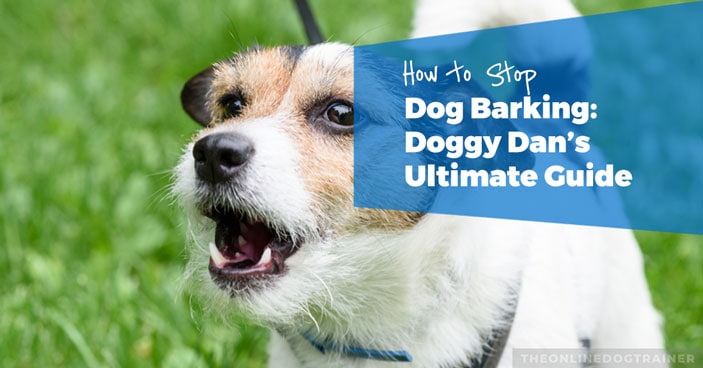
Out of all the bad dog behaviors that exist, how to stop dog barking has to be one of the most frustrating issues to deal with.
Think about it…
If your dog has a barking problem, it’s unlikely that you’re able to control when he barks. This can lead to his howling keeping you up at night, his barking interrupting your favorite TV shows, or even his unnecessary barking waking up small children from naps during the day.
Barking is also scary to some people who are not familiar with dogs. And your dog's constant barking might scare friends and family who come to visit you at your home. That’s no fun for anyone.
Or even worse…if your dog’s insistent barking carries on day in and day out and you live close to other people, it’s possible that your neighbors could call the cops for noise disturbances.
It’s heartbreaking, but noise disturbances are a big reason for dog’s being taken out of their loving homes.
Barking can be a big issue and one that is a huge frustration to dog owners I work with
But here’s the good news. There’s no barking problem, no matter how big or small, that can’t be fixed!
And today, I’m going to give you some valuable tips, tools and resources you can use to stop unwanted dog barking behavior starting today.
Let’s start with the basics…
Discover the Simplest Way to Stop ANY Barking Without Hurting Your Dog or Puppy
First of all, we have to identify WHY your dog is barking, because the solution we use depending on your dog's barking problem is not always going to be the same.
After all, you’d never use the same approach to stop a child who was shouting out for help as a child who was screaming at you for more chocolate, now would you?
You see, the reason your dog is barking is because he is not happy about something.
What is he not happy about?
Right now, I’m going to share with you the four most common reasons that dogs and puppies bark.
It’s not a comprehensive list, but most dogs and puppies will fall into one of these categories. Once you’ve decided which one best describes YOUR dog, then take a look at the action plan to put an end to it once and for all.
Sound like a plan?
I should add here that many years ago (when I was pretty new to dog training), I used to think that barking could all be sorted out with the same approach. Now I’m a few years older and wiser (hee hee), and I can see the error of my ways.
I’ve realized it’s so much easier to stop barking if you FIRST correctly understand why your dog is barking. And then apply an appropriate solution. Makes sense, doesn’t it?
So, here are the main reasons a dog will bark and how you can get started to make things better for you and your dog.
1. Barking Because Your Dog Wants Something
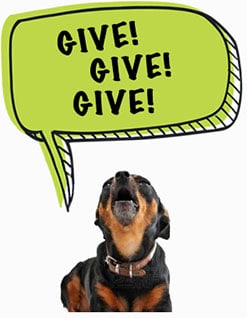
This type of barking occurs when your dog wants something, rather like a nagging child.
She's not happy and she's letting you know. So, it could be that she wants to come inside, be let out of the crate, be given some food, or she simply want your attention.
Ever had your dog tell you to speed up with dinner? Yep? Well that’s what I’m talking about.
How do you fix this?
Don’t reward bad behavior.
The key here is that you must not reward any bad behavior. For example, if your dog is barking outside to come inside, don’t let her in (I know it’s tempting and you don’t want to upset the neighbors). If you reward her with what she want, then it will happen again and again.
Think of it as a little short-term pain for some long-term gain!
Simply wait and ignore your dog until she's calm and then open the door. She’ll get the message pretty quickly.
Imagine a child shouting at you to do something…would you just give in to them? No…hopefully you would wait until she was were calm. It’s the same approach.
(Now if you are thinking “Well that won’t work with our little Rover, because he NEVER gives up,” then there are a lot of other tips and tricks which will convince even the most stubborn barking dogs that it’s best to be quiet, which I’ve added at the end.)
2. Barking Because Your Dog Thinks He Is in Danger
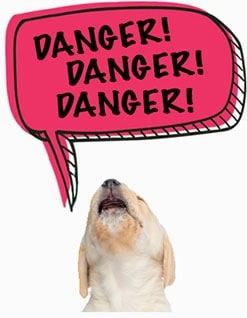
This type of barking can occur inside or outside the house.
However, to keep things simple, let’s imagine that it’s inside the house. Your dog hears a noise and jumps up, runs over to the window, and starts barking at the people outside your home.
Of course, your dog could be barking at other dogs, a noise he's heard, or something as small as a bird in a tree.
Whatever it is, imagine that there’s no need for your dog to respond with barking.
And what we want to communicate to our dogs is…“There is no need to bark.”
But first, let's look at where it all goes wrong! Now what typically happens here is:
Your dog barks…
You shout something at him (in a very authoritative manner)…only to find that your dog barks again even louder, and it all starts to escalate!
Eventually, you end up with you shouting your head off and your dog barking back at you,“I’m barking as loud as I can!”
Sound familiar?
How to fix this problem…
Stay calm and check it out.
What’s happening is your dog is mirroring your energy. So, rather than wind your dog up, let’s calm him down.
When she barks, simply say something like “Thank You,” in a VERY gentle voice (rather like you would whisper in somebody's ear).
Then if he continues with the barking, go and take a look out the window and again say “Thank You” very softly, before walking away. (Now I know this may seem odd, BUT it makes total sense to your dog – I promise!)
What you’ve just done is checked out the danger (even if it was just a bird in a tree) and calmly communicated to him using your body language, the tone of your voice and your energy that there’s no need to worry.
If he continues barking after you’ve done this then you can very calmly pop him into time out for a couple of minutes.
Of course, with all dog training, the more your dog takes notice of YOU the better! (Something I’ll explain a bit more later on). So, if your dog is not taking notice, then we need to go back a couple of steps and get his focus and attention first!
3. Barking When Your Dog Is Left Alone
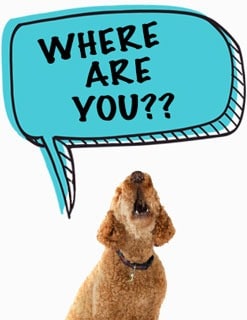 This type of barking is what’s generally known as “separation anxiety barking” because your dog becomes anxious after separation.
This type of barking is what’s generally known as “separation anxiety barking” because your dog becomes anxious after separation.
I should add here that this stress results not only in barking, but can also manifest in destructive behavior, chewing, injuring themselves, escaping, and excessive digging.
The great news is that the following approach will remove the cause of the problem and with it the stress. So, all of these issues will disappear.
Now, I should point out that this barking is NOT “naughty behavior” as many people think, nor has it anything to do with boredom which is why using a shock collar to try to stop this behavior is such a cruel idea. Let me explain.
Imagine you were sitting at home looking after your young child and suddenly noticed the toddler out on the street! What would you do?
Of course, you’d rush out and get her.
But…what if the doors were locked and you couldn’t get out?
Would you sit down, relax and have a cup of tea? Of course not. You’d shout for help and call your baby back, or try and break free so you could get back to her.
And THIS is why your dog becomes stressed.
You see, when our dogs think they are in charge, and responsible for looking after us, they automatically get very stressed when you leave. That’s why it only occurs when you are not there.
Here’s what to do…
Become the Pack Leader.
Now in this situation, I want to give you an overall idea of what to do and what not to do.
The key thing is to realize that your dog or puppy’s barking has got NOTHING to do with boredom! This means that trying to keep your dog occupied by leaving bones down and loads of chews and toys stuffed with peanut butter is unlikely to work.
In fact, it can make things much worse, so pick up the food.
Really, if it solved the problem everyone would say, “Hey, your dog’s barking—leave a bone down!”
Instead, what I would focus on doing is giving your dog the message you are the Pack Leader and there is no need for them to worry about where you are.
Now, one way you can do this is by leaving your home calmly and then coming home calmly and ignoring your dog. (I know this may sound a bit harsh to some of you, and it may not be what you want to do, but this advice is all about doing what’s best for your dog and how to stop the barking!)
Also, remember that they are animals, and just like ignoring the cat or a goldfish when you enter the house, it will not result in the dog being upset.
In fact, this is one of the key ways you can HELP your dog relax when you are not there.
It gives your dog the message that YOU are in charge, not him, and as explained above, it will help him stop worrying about you when you are not around. When you’re ready, you can always call your dog over to you, on your terms, for love and cuddles.
Now of course there’s a lot more to becoming the Pack Leader. It’s an essential key to having a happy, obedient dog, which I’ll touch on later.
4. Over-Excited Barking
 The fourth type of barking is over-excited barking.
The fourth type of barking is over-excited barking.
The best way to think of it is to imagine some children playing. As kids start to have fun they get excited, they start shouting and then start yelling with excitement.
They are NOT being naughty, but it can be really annoying, and it’s certainly something you want to keep a handle on.
Now of course with children, shouting at them does NOT work! And… it’s the same with dogs.
If the barking is starting to get out of control as they race around the garden playing, here’s what to do…
Use Calm Actions.
First, you need to step in and take control of them calmly without a word and then demonstrate calm energy by doing the calm freeze.
Here’s how it works…
The Calm Freeze:
- Crouch down.
- Take your dog by the collar, using an underhand grip, under the chin, palm facing up.
- ‘Say nothing, look away, and breathe slowly and deeply.
- Hold him for a couple of seconds until he is calm.
- Then release the hold and stand up…
- He will be much calmer.
Watch how the calm freeze works now…
To get a few more tools you can use, I encourage you to check out the rest of the blog post here.
Barking When Left Alone

One of the most common barking problems I encounter when working with dogs is separation anxiety barking like we discussed above. Because it’s such a big problem, I want to focus on this issue by itself for a few minutes.
It’s so important, in fact, that I created a podcast on the issue I think you’ll enjoy. Take a listen…
So, what’s in this podcast? Well let me explain:
Understanding the Cause
The first thing that I explain is the reason behind why most dogs bark when they are left alone. Very often, we assume or think that it is our dog’s way of showing us that he is bored or just being naughty; however, this couldn’t be further from the truth.
In fact, a good way to test out the bored theory is to ask yourself if your dog is bored when you are at home…
If he is calm and relaxed most of the day, then the chances are that your dog is not simply bored! (And dogs are not naughty for the fun of it, so that rules that out.)
The Two Main Causes
The two main scenarios that cause your dog to bark are trigger barking and separation anxiety.
They are very different scenarios. Trigger barking is where something sets your dog off and your dog simply does not stop. He is stressed and just keeps on going.
Whereas separation anxiety doesn’t need a trigger to get your dog barking. He simply becomes stressed when you leave and bark continuously.
Inside the podcast, I explain fully what is going on in these two situations and explain what the solution is.
Other Techniques
There are so many approaches to solving barking but most of them do not go to the root cause of the problem. In some situations, they can certainly help and are worth trying, however, I would recommend them only in conjunction with the basic solution that I have put together. On their own they are very unlikely to work.
Here is a short list of some things that impact your dog’s barking when he's alone…
- Exercise – does it help, is it the solution?
- The Environment – the impact that making your dog comfortable can have.
- Herbal remedies vs drugs – would I recommend them?
- Music, TV – whether it can help your dog.
- Inside vs outside – where is best for your dogLarge area or small – what will work best.
- Why harsh methods that just try to “stop the.
- barking” are missing the point.
To get all the remaining information you need on this topic, click here to read the entire blog post.
The Art of Remaining Calm: How to Stop a Boston Terrier Dog From Barking
Believe it or not, there are dog breeds that are more prone to having bad barking habits than other breeds. Which is exactly why I wrote the following article that focuses on the Boston Terrier breed…a dog that is known for being a bit too yappy.
That being said, it’s possible that any dog can have a barking problem.
And just because I used a specific breed in this example, doesn’t mean that the techniques I’m about to share with you won’t work with other types of dogs.
So, regardless of whether you have a terrier, a pit bull, or a border collie with a barking problem, I hope you’ll be able to use my example and implement the tools and techniques I’m about to share to help your dog overcome his barking problem.
Let’s jump right into it…
There Are Lots of Reasons Why a Dog Barks
Some dogs are simply over excited, some are being protective, and other times a dog simply wants something.
In this video below, I’m going to show you how to stop a Boston Terrier dog from barking.
Here’s some background information before we go any further…
In this video, Little Bella is barking to get attention, and she is excited and is trying to get my dogs to play. What I love to watch in this video is how Peanut, my larger dog, behaves.
Her body language and energy give me clues as to how best to deal with this and many other situations.
Here’s a quick overview of how Peanut handles different types of barking that I’ll show you in the video…
1. The Noisy Dog
Sometimes, as in this situation, if a dog is just barking too much for attention and fun, Peanut will ignore her and keep ignoring her until she gives up. Peanut remains completely calm and relaxed throughout the whole process. It helps Bella calm down.
2. The Space Invader
If a dog is being rude and is in her face barking, she will give a warning snap to the dog to back away and knock it off. As soon as she has done it, however, she is as calm as can be again. Relaxed and quiet.
3. A Dangerous Situation
If a dog is barking aggressively and there is a potential threat, Peanut will calmly and quietly walk away and give space to the other dog. Sometimes she has walked over 100 meters away before lying down. Very often the other dog, upon seeing this, will relax and chill out.
Enough explanation…check out the video now!
Interesting, isn’t it?
For additional information, I invite you to read the blog post in its entirety here.
I’ve also written another breed specific post on Bichon Frise barking. Once again, the techniques I share will work on any breed of dog, so I encourage you to check out that blog as well for additional information.
Barking is an annoying habit, but it doesn’t have to last forever.
If you’re looking for a solid plan to help resolve your dog’s bad barking behaviors, or you simply want to set a foundation that will prevent your dog from developing a barking habit, I recommend that you look into using my program call The Dog Calming Code. (Or, if you have a puppy, get started with my Puppy Coach training program!)
Click Here To Learn How To Stop YOUR Dog Barking Today
You’ve got nothing to lose…purchase The Dog Calming Code today to put an end to your dog’s barking behavior today.
Cheers!

~Doggy Dan




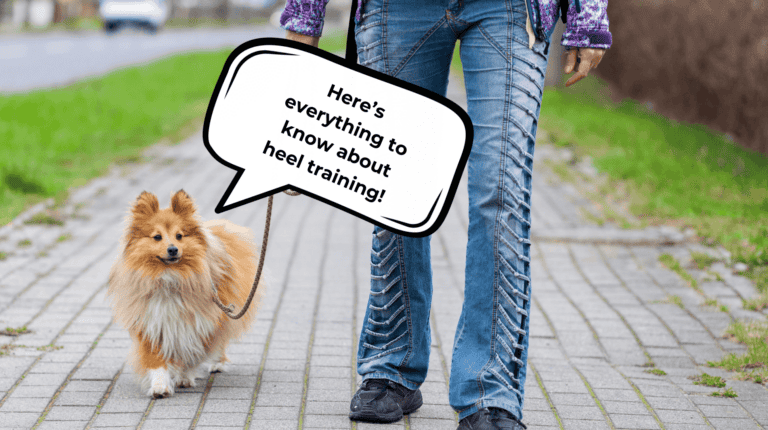
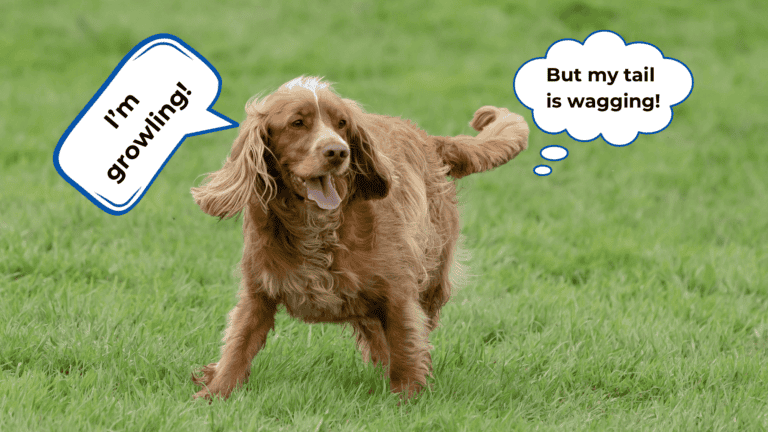
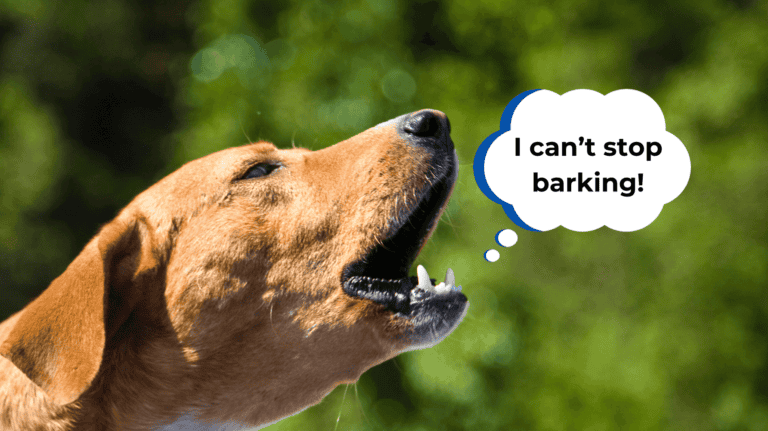

13 Responses
I had my little podenco maneto x girl from rescue in Spain 2 years ago to keep our 13 year old gsd boy company. They got on together brilliantly for a year until he passed away. she was born in rescue and was surrounded daily by more dogs than humans. The problem we have is she barks and growls at my partner. (no other men) (The gsd was his) it only takes a look in her direction. This isn’t aggressive but more fearful. ( he has never done anything to frighten her). The only time she is OK with him is in bed. She will cuddle with him, and when I ask her to say hello to him but then she’s not completely relaxed. She has no separation anxiety in the home. But when I am about or when we are out she gets very worked up if I am out of sight. Any ideas?
Hi Joanne,
When a family dog passes away it can be a big period of adjustment for any remaining dogs in the family, especially if the absent dog was higher ranking. Remaining dogs can really struggle to find their feet without the other dog there to reassure them and give confidence and so they can be quicker to panic. There is absolutely a way you can help your dog and with the right information she can return to her usual behaviour. My website TheOnlineDogTrainer.com shows you very clearly how to achieve this…maybe take a quick look…its a $1 trial for 3 days…all the best Doggy Dan
HI, Thank you so much for being here and for all the videos, I own a barber shop and tell everyone w dogs about you. One of my problems is I have 2 sister Blue Heelers that are in training to do service for customers such as helping persons getting up out of chairs, picking up dropped items etc. they r 1 yr and 5 months and have been to work every day since 6 weeks so r socialized. but every time the door opens they bark and sometimes scare people. i keep them behind a gate in my office when no one here so they wont run out unexpectedly when the door opens. then i will let them out to visit when calm. any ideas? I kind of float around the site checking all videos for more on my kind of situation so i don’t really know how to proceed. I, of course have done the golden rules several times and they have made amazing changes everyone has noticed. Thank you, Cheri
Hi Cheri,
Even though your dogs are use to having people come and go through your shop regularly, their instinct tells them that potentially these people could be dangerous. So their barking is an alert to let you know that danger may be at foot. When a dog barks in this scenario it can be really helpful to say something calm and positive to them, to show them that you aren’t worried about anything. A general ‘thank-you’ can work really well…..telling the dogs off or scolding them generally doesn’t! It’s important not to go overboard with verbal reassurance though as this can have the opposite effect. If they continue barking too much then calmly closing the door on them or placing them in another area of your shop where they can calm down a little may help as well.
My website TheOnlineDogTrainer.com has a broad section on barking…maybe take a quick look…its a $1 trial for 3 days…all the best Doggy Dan
I am a member presently of your website and wrote the last blog above. Actually my dog Cody is fairly calm getting in the back seat of the car (with the leash attached) and while I’m driving, but she can go wild barking if certain vehicles are driving toward us in the other lane. It seems that the size of the vehicle or truck (perhaps the color) makes her bark excessively. Is there any way of stopping this. My other older dog just lays down and does not react to this. They are Therapy dogs and we are in the car sometimes every day and they love riding with us. Except Cody’s problem is driving us crazy!
MY DOG DOES BARK WHEN OTHER PEOPLE OR ANIMALS ARE IN THE YARD AND I DO USE THE CALM FREEZE AND TIME-OUT (THANK YOU!). BUT THE MOST ANNOYING IS THE BARKING IN THE CAR. SHE IS IN THE BACK AND I CAN’T DO THAT TO CALM HER. WE HAVE TWO THERAPY DOGS AND CODY DOES THIS ALL THE TIME (ESPECIALLY WITH LARGE TRUCKS GOING ON PASSING US ON THE LEFT SIDE OF THE ROAD. WHAT CAN WE DO TO STOP THIS?
Hi Jean,
One of the thing I like to focus on when it comes to barking in the car is the process used to get the dog into the car in the first place. Ensuing that this is done calmly with your dog’s excitement levels at the lower end of the spectrum is helpful. I also only allow the dogs into the car on my request once they are calm and it can help to actually place them on leash to take them to the car so that you can encourage calmer behaviour. Another really practical technique can be to have your dogs crated in the car but this would depend on the set-up of your car as well. My website TheOnlineDogTrainer.com shows you very clearly how to work you dogs through this behaviour…maybe take a quick look…its a $1 trial for 3 days…all the best Doggy Dan
Barking please help! I am a member and tried writing to the forum and also here. I LOVE the membership it literally changed my dogs behavior and made me the pack leader in days. My issue is that I had my Shepard/Collie mix completely trained to stop barking when I calmly said “Thank you”. He is now almost totally deaf and cannot hear the command. I can handle it if I am close enough to touch him or grab his collar. Do you have any solutions for when he is out of my range? Thanks Jen
Hi Jen,
Glad you have found my membership website so helpful!
This is a good point you raise, with deaf dogs and barking. My suggestion is to simply bypass the ‘thank-you’ step and move straight on to going to where your dog is so that they see you assessing the ‘danger’. It does require a little more effort but it will be effective in stopping the barking and reassuring your dog that everything is ok.
I do know of a vibrating collar that is designed with deaf dogs in mind, to be able to get their attention at range. I must stress that this collar is not an E-Collar or shock collar, these are very different devices and I don’t recommend the use of them. The vibrating collar emits a very low level vibration, not a shock, that helps owners in place of using your voice to get your dog’s attention. If you do look into this collar please make sure you are not purchasing a shock/E-collar, or one designed to cause pain or discomfort. I cannot stress that enough! All the best….Doggy Dan
I enjoy these videos so much. It teaches me more than anything else does. Unfortunately though… PIpi my foxy jack Russell puppy heard Bella and is now barking his love out to her excitedly. Thanks for the vids!
Thanks Trish, I’m glad you find my videos helpful! All the best, Doggy Dan
very interesting. my problem with my jack russell Hugo, is this, when visitors arrive, he barks a greeting (thats if i didnt know they were coming.. if i do i put him in another room till they are in and settled on settee or chair then bring him in ).no jumping up then, and he stands waiting for them to fuss him. buttttt if they get up to go, be it home or the loo, or put their coat on even before standing up, he goes crackers, barks like mad. doesnt want them to leave. if he realises that i have turned my computer off in daytime (doesnt do this at bedtime though), changed my computer specs for my distance ones, and a few other small things i do in readiness for going out , he barks like mad (not after ive left though… i could hear him right to end of our cul de sac if he did)… only other time is warning me someone is outside. he soon stops when i go to look. but the visitor leaving one is a nuisance. i try puttin him in other room when i am warned the visitor is leaving but they dont always tell me, even if i remind them when they arrive.so we get the “no you are not leaving that chair” barking.. and jumping around in front of them..
Hi Doreen,
This kind of barking may be your dog’s attempt to try and prevent people from leaving the house as he may feel he cannot protect them if they go out into the big wide world without him. Even though visitors aren’t part of your family a dog can temporarily include them as someone that they may need to take care of. You see we have the foresight to know that the visitor is only around temporarily but your dog has no idea if they are part of your family for good or not. It is also most likely why he gets a little worked up when he realises you are preparing to go out. Dogs are very good at picking up on these cues, subtle or otherwise, and it can then effect their behaviour.
Sp when your dog starts to get a bit excited at guest leaving calmly take hold of his collar, or clip a leash on him, and hold him still gently. I would avoid trying to tell him to shush or that everything is ok as this can be counterproductive. If he continues barking then calmly place him in another room and out of the way until he is quiet and then bring him out again but repeat the process if he continues to bark.
If you are interested in more information my website TheOnlineDogTrainer.com deals quite comprehensively with barking…maybe take a quick look…its a $1 trial for 3 days…all the best Doggy Dan